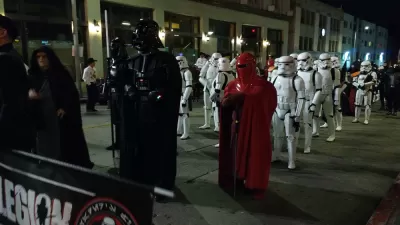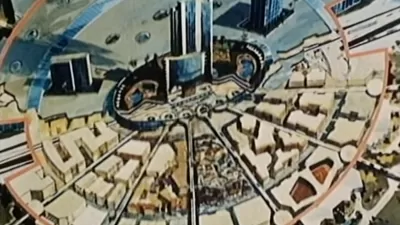Rachel James speaks with historian Jennifer Gray about the impact that Disney's "particular brand of nostalgic, comforting architecture and urbanism" has had on the way people experience the city and professionals plan for it.
"Less radical than incrementally progressive" when seen in the tradition of traveling carnivals and permanent amusement parks, Disneyland was nevertheless pioneering in its marketing and design, and particularly in its "architecture of reassurance," says Gray.
Although Disneyland's sentimental architecture is easily caricatured, Gray believes that Disney's approach to the physical and socio-political aspects of urbanism have been more profound. "Disney
amusement parks create an expectation among visitors that cities should
be immaculate, apolitical, highly ordered spaces populated, for the most
part, by people not unlike themselves."
"In recent years Disney-urbanism has colonized authentic cities," notes Gray. "Urban
entertainment districts such as South Street Seaport in New York,
Quincy Market in Baltimore, and Harbor Place in Baltimore are good
examples. South Street Seaport conveys the impression of a once-active
seafaring culture, but without the messiness of a functioning seaport –
the smell of fish, working-class dockhands, clamoring fish mongers.
Instead we find national retail and restaurant chains like The Gap and
McDonald's."
Concludes Gray, "[d]espite the fact that Disneyland is not a city but an amusement park,
Karal Ann Marling points out that it does ask the right questions: 'What
should the city look like? And who or what should be in control?'
Perhaps we just need different answers to those questions."
FULL STORY: Q&A: What Disney can teach us about urban planning

Planetizen Federal Action Tracker
A weekly monitor of how Trump’s orders and actions are impacting planners and planning in America.

Map: Where Senate Republicans Want to Sell Your Public Lands
For public land advocates, the Senate Republicans’ proposal to sell millions of acres of public land in the West is “the biggest fight of their careers.”

Restaurant Patios Were a Pandemic Win — Why Were They so Hard to Keep?
Social distancing requirements and changes in travel patterns prompted cities to pilot new uses for street and sidewalk space. Then it got complicated.

Platform Pilsner: Vancouver Transit Agency Releases... a Beer?
TransLink will receive a portion of every sale of the four-pack.

Toronto Weighs Cheaper Transit, Parking Hikes for Major Events
Special event rates would take effect during large festivals, sports games and concerts to ‘discourage driving, manage congestion and free up space for transit.”

Berlin to Consider Car-Free Zone Larger Than Manhattan
The area bound by the 22-mile Ringbahn would still allow 12 uses of a private automobile per year per person, and several other exemptions.
Urban Design for Planners 1: Software Tools
This six-course series explores essential urban design concepts using open source software and equips planners with the tools they need to participate fully in the urban design process.
Planning for Universal Design
Learn the tools for implementing Universal Design in planning regulations.
Heyer Gruel & Associates PA
JM Goldson LLC
Custer County Colorado
City of Camden Redevelopment Agency
City of Astoria
Transportation Research & Education Center (TREC) at Portland State University
Camden Redevelopment Agency
City of Claremont
Municipality of Princeton (NJ)





























